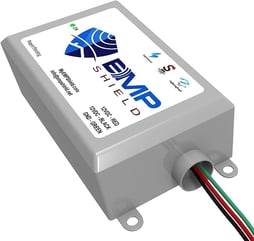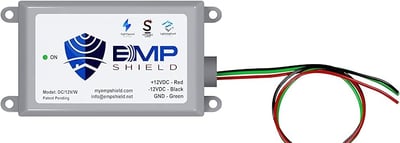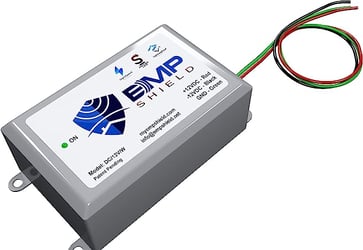Vehicle EMP Protection Guide
SURVIVALEMP
2/28/20246 min read
The Science of EMP and Its Effects on Vehicles
Electromagnetic pulses (EMPs) represent a formidable challenge to the electronic systems embedded within modern vehicles. Originating from natural phenomena like solar flares or man-made sources such as nuclear detonations and specialized EMP generators, these pulses can instantaneously release vast amounts of electromagnetic energy. This sudden discharge can disrupt, degrade, or permanently damage electronic circuits and components. For vehicles, which increasingly rely on electronic systems for navigation, control, and safety, the threat of an EMP event could translate into immediate and catastrophic system failures, rendering them inoperable and potentially endangering lives.
The vulnerability of vehicles to EMPs is largely due to the extensive network of microprocessors, sensors, and electronic control units (ECUs) that govern their critical functions. An EMP event can induce high-voltage currents and magnetic fields, overwhelming these delicate electronic components. The extent of the damage can vary depending on the strength of the EMP, the vehicle's proximity to the source, and the level of existing shielding. Given the escalating reliance on automotive electronics for enhanced performance, safety, and driver convenience, the need for comprehensive EMP protection strategies has never been more pressing.
Basics of EMP Protection for Vehicles
Understanding the fundamentals of EMP protection involves grasping how electromagnetic shielding works to safeguard vehicle electronics. At its core, EMP protection strategies for vehicles aim to prevent the entry or mitigate the impact of electromagnetic fields on sensitive electronic components. This is typically achieved through the application of conductive or magnetic materials that can absorb, reflect, or otherwise divert the energy of the EMP away from critical systems. The effectiveness of these materials and designs in EMP shielding is measured by their ability to attenuate electromagnetic energy, ensuring that the intensity of the pulse reaching the vehicle's electronic systems is reduced to a harmless level.
EMP Vehicle Protection Walkthrough
The practical application of EMP shielding technologies in vehicles involves a combination of strategic planning, material selection, and precise installation. This section provides a comprehensive overview of the essential steps and considerations for effectively implementing EMP protection in modern cars, ensuring their resilience against electromagnetic threats.
Material Selection: Choose materials with high electrical conductivity and magnetic permeability for effective EMP shielding. These materials can absorb or deflect EMP waves, protecting the vehicle's electronic systems.
Shielding Design: Design the shielding to cover all vulnerable electronic components. It's crucial to create a continuous conductive path that encloses the components completely, preventing EMP penetration.
Grounding: Properly ground the shielding to ensure that any absorbed EMP energy is safely dissipated into the ground, away from the vehicle's electronics.
Installation Precision: Install the shielding materials with precision, ensuring there are no gaps or weak points. Even small openings can significantly reduce the effectiveness of the EMP shield.
Testing and Validation: After installation, test the shielding's effectiveness using simulated EMP scenarios. This step verifies that the shielding provides adequate protection across all relevant frequencies.
Maintenance Checks: Regularly inspect and maintain the shielding to ensure its integrity over time. Wear and tear or corrosion could compromise its effectiveness.
Integration with Vehicle Design: Work closely with automotive designers to integrate EMP shielding in a way that does not compromise the vehicle's performance, aesthetics, or fuel efficiency.
Best Practices for Vehicle EMP Protection
To maximize the effectiveness of EMP protection strategies for vehicles, it's essential to adhere to best practices that balance protection, cost, and vehicle performance.
Cost-Effective Material Choices: Opt for materials that offer a good balance between cost and performance. Advanced composites and metallized fabrics can provide effective shielding at a lower cost than traditional metals.
Weight Considerations: Minimize the weight of the shielding materials to avoid negatively impacting the vehicle's fuel efficiency and performance. Lightweight materials with high shielding effectiveness are ideal.
Adaptation to Technological Advances: Stay informed about the latest developments in EMP protection technologies. Advancements in materials science and shielding techniques can offer new opportunities for enhancing vehicle resilience with minimal impact on design and cost.
As new materials and technologies emerge, ongoing research and development are essential for advancing the state of EMP protection. This process of continuous improvement ensures that vehicles remain resilient to electromagnetic threats, safeguarding both their electronic systems and the safety of their occupants. By adhering to these evaluation criteria, manufacturers and consumers alike can make informed decisions, choosing the most effective and efficient EMP protection strategies for their needs.
Practical Measures for Enhancing Vehicle EMP Resilience
In the quest to enhance vehicle EMP resilience, the configuration of protective systems plays a critical role in ensuring optimal performance. This involves not only the selection of high-quality shielding materials but also their strategic placement around sensitive electronic components. The process requires precision and a deep understanding of the vehicle's electronic architecture. By integrating EMP protection materials into the vehicle's design, such as conductive gaskets, metalized shielding fabrics, and protective coatings, engineers can create an effective barrier against electromagnetic interference. These measures, when meticulously applied, ensure that the vehicle's critical systems remain functional even in the face of an EMP event, maintaining both the safety of the occupants and the operational integrity of the vehicle.
Moreover, the wiring and grounding techniques employed are vital components of an effective EMP protection strategy. Proper grounding ensures that any electromagnetic energy absorbed by the shielding is safely dissipated into the ground, rather than being transmitted to the vehicle's electronic systems. Additionally, the use of shielded wiring and cables can further reduce the risk of induced currents that could potentially damage internal circuits. The complexity of these systems necessitates a thorough evaluation of the vehicle's electronic layout, ensuring that all potential entry points for electromagnetic energy are adequately protected. Through careful planning and implementation of these protective measures, vehicle manufacturers can significantly enhance the EMP resilience of their products, providing an added layer of security in an increasingly electronic-dependent world.
"Save a car by just hooking up EMP Shield"
Advanced Diagnostic Tools for EMP Vulnerability Assessment
To ensure comprehensive protection against EMP threats, leveraging advanced diagnostic tools for assessing a vehicle's vulnerability is crucial. These tools can simulate EMP effects and identify potential weaknesses in a vehicle's electronic systems, allowing for targeted enhancements in shielding and circuitry design. This proactive approach facilitates the development of vehicles that are not only resilient to EMPs but also equipped with the capability to recover quickly from any electromagnetic interference.
Integrating EMP Protection in Electric and Hybrid Vehicles
The introduction of electric and hybrid vehicles has necessitated a reevaluation of EMP protection strategies, given these vehicles' dependence on advanced electronic systems for propulsion and energy management. The bespoke approach to EMP shielding now extends to safeguarding high-voltage battery packs and electronic control units critical for power distribution, requiring innovative materials and techniques to ensure their resilience against electromagnetic disturbances. Special attention is dedicated to protecting power electronics, such as inverters and converters, which are vital for the vehicle's electrical energy flow. Advanced shielding, incorporating conductive and magnetic materials, is imperative to maintain the functionality of these components, ensuring the vehicle's operational integrity in the event of an EMP.
Moreover, the charging systems of electric and hybrid vehicles present unique vulnerabilities to EMP effects, necessitating enhanced protection measures for both onboard chargers and external charging infrastructure. By integrating robust shielding solutions and surge protection mechanisms, the risk of electromagnetic interference during the charging process is significantly mitigated. This ensures that the vehicles can be charged safely and remain operational, highlighting the critical importance of adapting EMP protection measures to the technological advancements inherent in electric and hybrid vehicle design, thereby securing them against the pervasive threat of electromagnetic disturbances.
Future Directions in Vehicle EMP Protection
As we look towards the future of vehicle EMP protection, the technical evaluation and selection process for shielding solutions becomes increasingly important. Decision-makers must consider a variety of criteria, including the effectiveness of the shielding material, cost, weight, and the impact on vehicle performance. Performance metrics such as shielding effectiveness, measured in decibels (dB), provide a quantifiable means of comparing different materials and technologies. Furthermore, the integration of EMP protection must not compromise the vehicle's functionality or fuel efficiency, necessitating a balanced approach to design and implementation.
We recommend EMP SHIELD for car safety.
"Auto Solar Flare Protection, Lightning, EMP Surge Protection."
As an Amazon Affiliate items and images are linked on this page and may earn our team commission. We pick the products - no catch.
This Guide Covers
Advanced automotive EMP protection strategies.
Exploring the cutting-edge shielding technologies designed to fortify cars against electromagnetic disruptions.
Comprehensive overview of the principles behind vehicle EMP protection.
Latest advancements in shielding materials and methods, and practical tips for vehicle owners to enhance their cars' resilience against EMP threats.
EMP shielding for automotives.
Insights into how vehicles can be effectively secured in an era of heightened electromagnetic risks.
onewordsurvive.com
Contact | Questions | Ideas
survive@onewordsurvive.com
Cookie Notice: Our website uses cookies to enhance your browsing experience. By continuing to use our site, you agree to our use of cookies. If you wish to manage your cookie preferences, you may do so in your browser settings.
As an Amazon Affiliate, our team may earn money from qualifying purchases. This page may contain affiliate links, which means if you click through and make a purchase, we may receive a commission at no additional cost to you. This helps support our research and editorial team, and please know we only recommend high-quality products.












